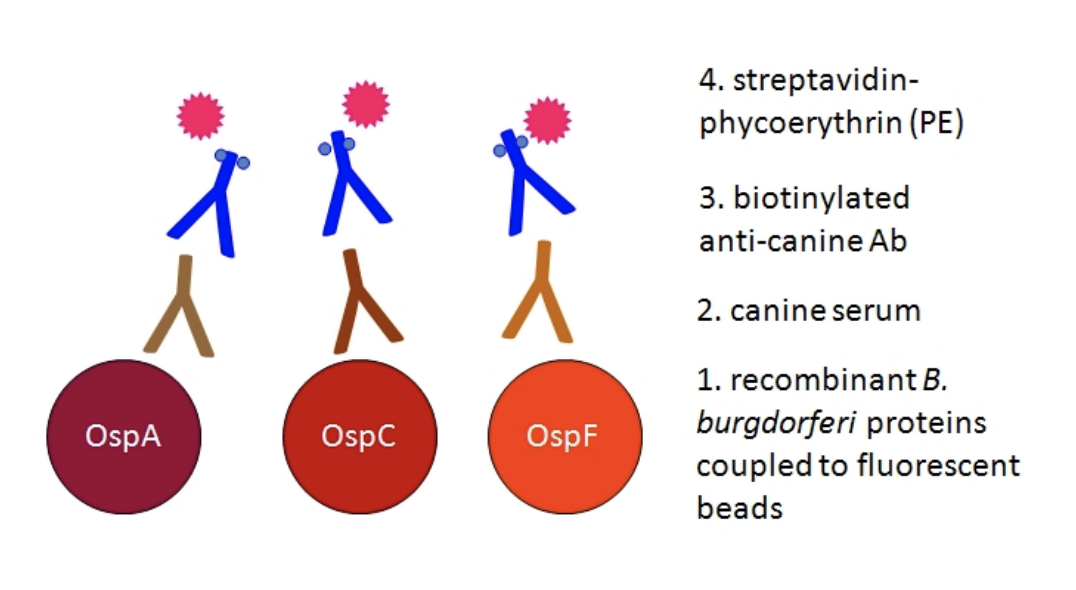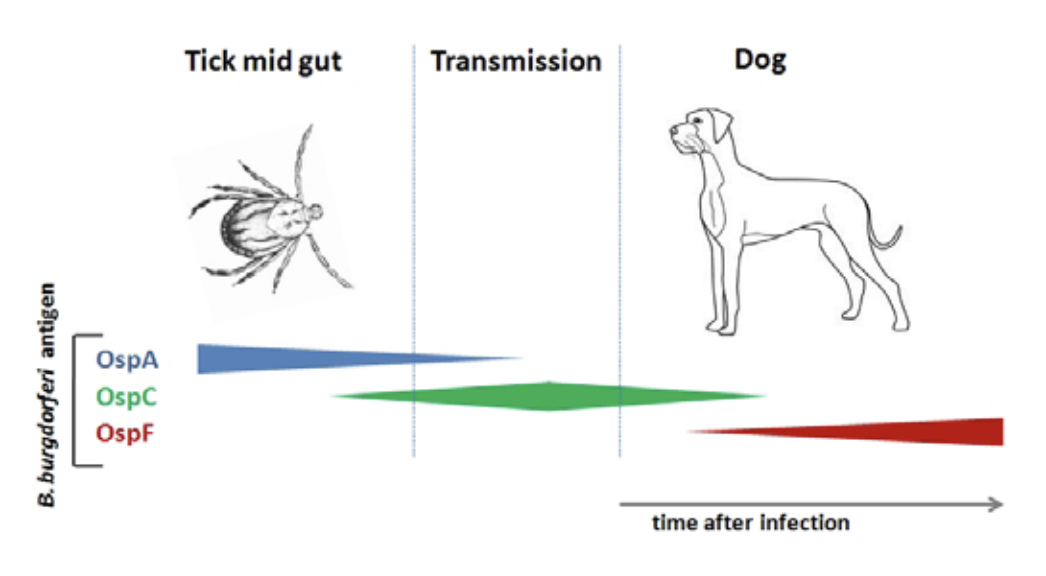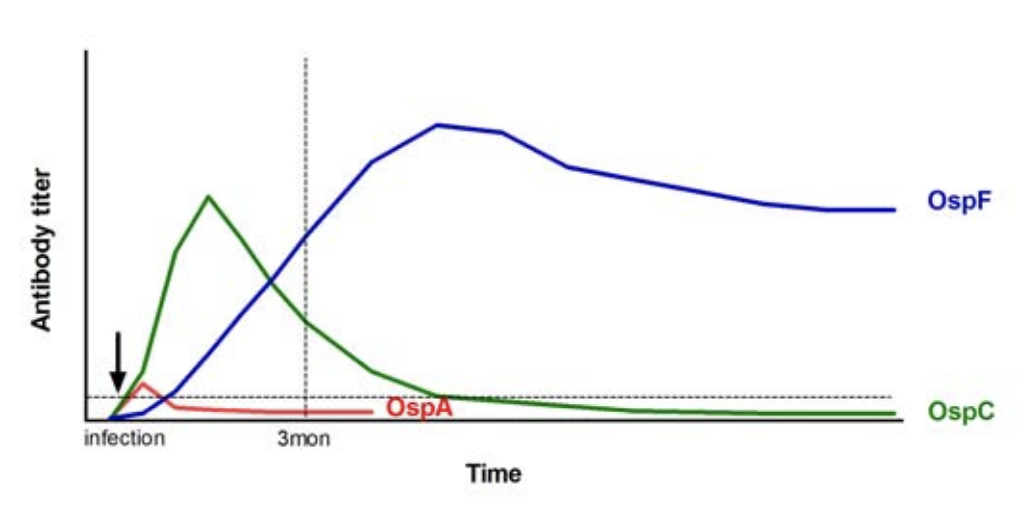Lyme Disease Multiplex Testing for Dogs
Background
Lyme disease is induced by the spirochete B. burgdorferi. Spirochetes are transmitted to dogs by infected ticks. Similar to humans, dogs are incidental, dead-end hosts for B. burgdorferi1 . Typical clinical signs in dogs are sporadic fever, acute arthritis, arthralgia, lameness, and glomerulopathy2-4. Clinical signs of lameness often develop two to five months after infection. B. burgdorferi can persist for at least one year in clinically recovered, untreated dogs3. In a report from 1992, clinical signs of Lyme disease were estimated to occur in 5-10% of seropositive animals5. This percentage likely underestimates the current Lyme disease prevalence for dogs in endemic areas due to a higher awareness of the disease in owners and veterinarians and improved diagnostic methods.

Serum antibodies to different antigens of B. burgdorferi are commonly used to identify dogs that were exposed to the pathogen and to diagnose Lyme disease in dogs with compatible clinical signs2,6-8. Former ELISA based diagnostic tests identified antibodies as early as four to six weeks after infection3. The new Lyme Multiplex assay can identify antibodies to B. burgdorferi by three weeks after infection9. High antibody levels were found in serum of experimentally infected dogs for at least seventeen months3 and are likely maintained for much longer times, i.e. as long as B. burgdorferi persists in the dog.
How does the Canine Lyme Multiplex Assay work?
The Canine Lyme Multiplex Assay was developed at the Animal Health Diagnostic Center at Cornell University. It detects antibodies to three B. burgdorferi antigens in canine serum (Fig. 1). The test is based on fluorescent beads and allows the simultaneous measurement of antibodies to all three B. burgdorferi antigens in a single sample10,11.

Which B. burgdorferi antigens are used and how is the test interpreted?
The Canine Lyme Multiplex Assay is based on three antigens, called outer surface proteins (Osp), of B. burgdorferi. Various research studies have shown that Osp antigen expression changes on the bacterial surface in response to tick feeding and again after infection of a warm-blooded host, such as dogs, horses, or humans (Fig. 2). In response to infection, dogs develop antibodies to these Osp proteins and testing for antibodies to specific Osp antigens can assist in the diagnosis of infection and Lyme disease.
Interpretation of Lyme multiplex results9,10
The Lyme Multiplex Assay is a fully quantitative test. It results in a numeric antibody value for each of the three B. burgdorferi antigens tested. An interpretation of each value is submitted with the test report. In addition, the antibody profile gives an advanced interpretation on the infection and vaccination status of the dog. Antibodies to OspA serve as markers for vaccination and those to OspC and OspF as markers for infection (Fig. 3). In infected dogs, quantitative antibody values can then be used to follow-up on treatment success.

- OspA – positive values for antibodies to OspA are typically observed in vaccinated dogs. OspA is expressed while B. burgdorferi persists in the tick mid-gut and also while the bacteria are cultured in-vitro. During infection of mammalian hosts, the bacteria down-regulate OspA. Therefore, antibodies to OspA are almost undetectable after natural infection in non-vaccinated dogs. Very low positive, transient antibody values to OspA can sometimes be detected two to three weeks after infection9.
- OspC – is a valuable indicator for early infection with B. burgdorferi. Antibodies to OspC are detected as early as two to three weeks after infection. Antibodies to OspC decline after seven to eleven weeks and become undetectable by four to five months after infection9.
- OspF – is an indicator of chronic infection. Antibodies to OspF are detectable by five to eight weeks after infection and are maintained at high levels afterwards. Researchers at Cornell observed a very high agreement between antibodies to OspF and C6 as robust markers for infection in dogs in a blinded study9. Dogs with positive antibody values to OspF and negative antibody values to OspC have been infected with B. burgdorferi for at least five months (Fig. 3).
Advantages of the Canine Lyme Multiplex Assay
The Canine Lyme Multiplex Assay is available only at the Animal Health Diagnostic Center at Cornell University. It combines the results obtained by previous ELISA and Western blot testing and exceeds the information obtained by tests that are based on a single antigen of B. burgdorferi such as C6. The Lyme Multiplex Assay provides information whether the dog got infected with B. burgdorferi and when the infection occurred. The test results are fully quantitative and appropriate to follow-up on treatment success or response to vaccination. The advantages of the Lyme Multiplex Assay compared to other Lyme tests are:
-
assay results distinguishing between:
- early and chronic stages of infection; Antibodies to OspC and OspF serve as markers for infection. Combined antibody values for OspC and OspF can also identify the stage of infection with B. burgdorferi and can determine when the dog was infected. In humans, early infection stages have a better prognosis and increased success rates after anti-biotic treatment than chronic infection stages. The same trends have been observed in dogs. A more rapid decline of antibodies, indicating successful treatment, was observed in many dogs that were treated in the early infection stage.
- vaccination and infection; The assay provides a separate quantitative value for antibodies to OspA, as a marker for vaccination, and to determine the dog’s vaccination status.
- increased specificity and sensitivity; Improved test performance results in earlier detection of antibodies to B. burgdorferi (as early as two to three weeks after infection) and a higher accuracy of the Lyme multiplex assay compared to conventional ELISA assays.
- quantitative measurement of individual antigens; The Lyme Multiplex Assay has a much broader linear quantification range than ELISAs. Antibody values are precisely measured in a broad concentration range. Quantification of antibodies and evaluation of treatment success can be performed based on declining antibody values. Successful antibiotic treatment decreases the bacterial load. The reduced or missing antigenic stimulus causes the immune system to produce fewer antibodies which then leads to a decrease in serum antibodies against B. burgdorferi. Treatment decisions and follow-up should always be based on a quantitative antibody test. Follow-up by Lyme Multiplex testing can be performed earlier than with conventional ELISAs.
The Lyme Multiplex Assay result provides advanced information beyond any of the currently available Lyme disease testing methods. Lyme Multiplex Assay testing allows a better definition of the dog’s current infection status and assists in determining treatment options and prognosis. The infection status can also be determined in most vaccinated dogs. Interpretation varies slightly depending on the vaccine used.
Treatment and treatment follow-up using the Canine Lyme Multiplex Assay
For treatment options and recommendations for infected dogs with or without clinical signs of Lyme disease, we refer to the ACVIM small animal consensus statement on Lyme disease in dogs3.
In addition to improvement of clinical signs, the evaluation of treatment success is performed based on declining antibody values to B. burgdorferi. The evaluation requires a pre- and post-treatment sample. Successful antibiotic treatment decreases the bacterial load. The lower or missing antigenic stimulus causes the immune system to produce fewer antibodies which leads to a decrease in serum antibody values. The decline of antibodies is slower than the bacterial clearance caused by the antibiotic treatment. After successful treatment, IgG antibodies to B. burgdorferi decline according to their half-life of around twenty-one days. A decrease of a positive antibody value by at least 50% of the original value in the time frames mentioned below is considered an indicator of treatment success. After successful treatment, antibodies will continue to drop without further treatment and will become negative over time if no re-infection occurs. The best timing for follow-up testing depends on the stage of infection. For example:
For chronic infection stages (OspC-/OspF+): Follow-up testing with the Lyme Multiplex Assays can be performed as early as three months after starting treatment. It should not be performed earlier to give the antibodies time to decline. A successful treatment is indicated by a clear drop in OspF antibody values (≥ 50% of the pretreatment value obtained three months earlier). A treatment failure (persistent infection) or reinfection after treatment is indicated by OspF antibody increases, no or minor decreases or alternating antibody values (minor drop followed by increase after re-testing). In case of a reinfection, OspC antibodies will also become positive.
For early infection stages (OspC+/OspF+ or OspC+/OspF-): Treatment follow-up can be performed as early as six weeks after beginning of the treatment. Early in infection, antibodies have been observed to decline more rapidly. This is likely due to a higher amount of IgM antibodies during early infection and a more rapid decline of IgM compared to IgG. A successful treatment is indicated by a clear drop in OspC (and if positive also OspF) antibody values to ≥ 50% of the pretreatment value obtained six weeks earlier. A treatment failure (persistent infection) or reinfection after treatment is indicated by OspC and/or OspF antibody increases, no or minor decreases or alternating antibody values (minor drop followed by increase after re-testing).
Special considerations for vaccinated dogs
The Canine Lyme Multiplex Assay can distinguish between vaccinated and infected dogs. All currently available vaccines for dogs induce antibodies to OspA. Therefore, the results on antibodies to OspA should be used to determine the dog’s vaccination status. However, some of the available vaccines also induce antibodies to other Osp antigens. To provide our clients with the best interpretation for each animal, we need information on the vaccine used. Please include the name of the vaccine and the date when the dog was last vaccinated on the submission form if a sample of a vaccinated dog is submitted for testing.
How can the Lyme Multiplex Assay be compared to other serological Lyme assays?
Researchers at the Animal Health Diagnostic Center at Cornell University have compared the former ELISA/Western blot procedure and the commonly used C6-based assays with the Canine Lyme Multiplex Assay9. Lyme Multiplex Assay OspF and C6 results highly correlate for the identification of infected or non-infected dogs. Antibodies to OspF and C6 provide robust markers of infection in dogs. However, the multiplex assay provides additional information on the dog’s infection stage (early or chronic) and vaccination status.
Sample submission
For detection of antibodies to B. burgdorferi, 2ml of dog serum needs to be submitted. Serum should be collected in a red top blood tube. The entire red blood tube or isolated serum should be shipped by overnight shipment on an ice pack to the Animal Health Diagnostic Center at Cornell University. For more information, please see the submission page.
Samples are tested every day (Mon-Fri) and results are available one to two days after the sample arrives at the laboratory. Consultation on Canine Lyme Multiplex testing and on result interpretation is available by calling the Serology/Immunology laboratory at the Animal Health Diagnostic Center at Cornell University.
References
- Radolf JD, Caimano MJ, Stevenson B, Hu LT. 2012. Of ticks, mice and men: understanding the dual-host lifestyle of Lyme disease spirochetes. Nature Rev. Microbiol. 10, 87-99.
- Levy SA, Magnarelli LA. 1992. Relationship between development of antibodies to Borrelia burgdorferi in dogs and the subsequent development of limb/joint borreliosis. J. Am. Vet. Med. Assoc. 200, 344-347.
- Appel MJG, Allan S, Jacobson RH, Lauderdale TL, Chang YF, et al. 1993. Experimental lyme disease in dogs produces arthritis and persistent infection. J. Infect. Dis. 167, 651-664.
- Littman MP, Goldstein RE, Labato MA, Lappin WR, Moore GE. 2006. ACVIM small animal consensus statement on Lyme disease in dogs: diagnosis, treatment, and prevention. J. Vet. Intern. Med. 20, 422-434.
- Levy SA, Magnarelli LA. 1992. Relationship between development of antibodies to Borrelia burgdorferi in dogs and the subsequent development of limb/joint borreliosis. J. Am. Vet. Med. Assoc. 200, 344-347.
- Jacobson RH, Chang YF, Shin SJ, 1996. Lyme disease: laboratory diagnosis of infected and vaccinated symptomatic dogs. Semin. Vet. Med. Surg. (Small Anim.) 11, 172-182.
- Wittenbrink MM, Failing K, Krauss H. 1996. Enzymelinked immunosorbent assay and immunoblot analysis for detection of antibodies to Borrelia burgdorferi in dogs. The impact of serum absorption with homologous and heterologous bacteriae. Vet. Microbiol. 48, 257-268.
- Guerra MA, Walker ED, Kitron U. 2000. Quantitative approach for the serodiagnosis of canine lyme disease by the immunoblot procedure. J. Clin. Microbiol. 38, 2628-2632.
- Wagner B, Freer H, Rollins A, Garcia-Tapia D, Erb HN, et al. 2012. Antibodies to Borrelia burgdorferi OspA, OspC, OspF and C6 antigens as markers for early and late infection in dogs. Clin. Vacc. Immunol., PMID:22336289.
- Wagner B, Freer H, Rollins H, Erb H.N. 2011. A fluorescent bead-based multiplex assay for the simultaneous detection of antibodies to B. burgdorferi outer surface proteins in canine serum. Vet. Immunol. Immunopathol., 140, 190-198.
- Wagner B, Freer H, Rollins A, Erb HN, Lu Z, Gröhn Y. 2011. Development of a multiplex assay for detection of antibodies to Borrelia burgdorferi in horses and its validation using Bayesian and conventional statistical methods. Vet. Immunol. Immunopathol., 144: 374-381.


